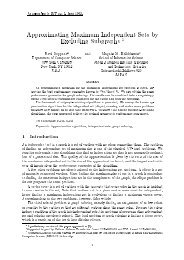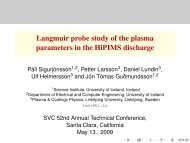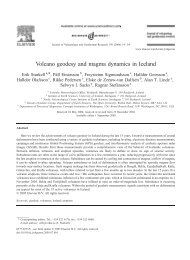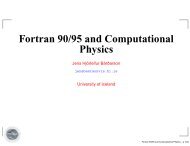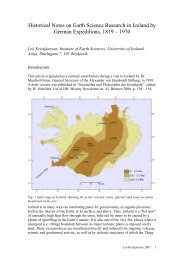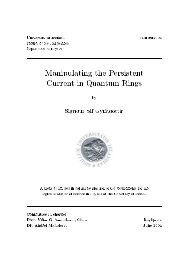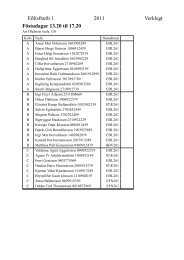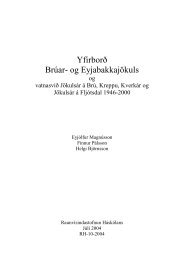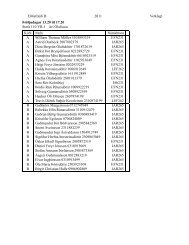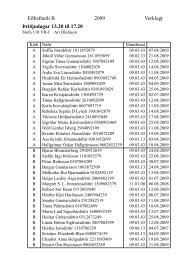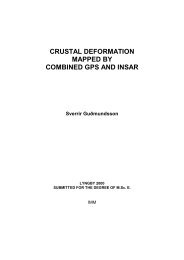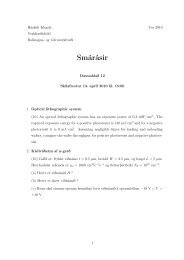HiPIMS
HiPIMS
HiPIMS
- No tags were found...
Create successful ePaper yourself
Turn your PDF publications into a flip-book with our unique Google optimized e-Paper software.
<strong>HiPIMS</strong>Ionization Processes in the High Power ImpulseMagnetron Sputtering Discharge (<strong>HiPIMS</strong>)Jón Tómas GuðmundssonScience Institute, University of Iceland, IcelandDepartment of Electrical and Computer Engineering, University of Iceland, Icelandtumi@hi.is59th Gaseous Electronics Conference, October 10. 2006
<strong>HiPIMS</strong>IntroductionThe demand for new materials and layer structures haslead to development of more advanced sputtering systemsOne such sputtering system is thehigh power pulsed magnetron sputtering discharge(HPPMS)high power impulse magnetron sputtering discharge(<strong>HiPIMS</strong>)It gives high electron density and highly ionized flux of thesputtered materialThe energy of the ions can be tailored to obtain impingingparticles with energies comparable to typical surface andmolecular binding energies
<strong>HiPIMS</strong>IntroductionThis work is a result of collaboration withKristinn B. Gylfason (now at Royal Institute of Technology inStockholm)Dr. Jones Alami (now at RWTH Aachen, Germany)Dr. Johan Bohlmark (now at Chemfilt Ionsputtering AB)Dr. Arutiun Ehiasarian (Sheffield Hallam University, UK)Prof. Ulf Helmersson (Linköping University, Sweden)
<strong>HiPIMS</strong>Planar Magnetron Sputtering DischargeA typical dc planar magnetron discharge operates at apressure of 1 – 10 mTorr with a magnetic field strength of0.01 – 0.05 T and at cathode potentials 300 – 700 VElectron density in the substrate vicinity is in the range10 15 − 10 16 m −3low fraction of the sputtered material is ionized (∼ 1 %)the majority of ions are the ions of the inert gasadditional ionization by a secondary discharge (rf ormicrowave)
<strong>HiPIMS</strong>High Power Impulse Magnetron Sputtering (<strong>HiPIMS</strong>)In a conventional dc magnetron dischargethe power density is limited by thethermal load on the targetMost of the ion bombarding energy istransformed into heat at the targetIn unipolar pulsing the power supply is atlow (or zero) power and then a highpower pulse is supplied for a short periodThe high power pulsed magnetronsputtering discharge uses the samesputtering apparatus except the powersupply
<strong>HiPIMS</strong><strong>HiPIMS</strong> - Power supplyThe high power pulsed discharge operates with aCathode voltage in the range of 500-2000 VCurrent densities of 3-4 A/cm 2Power densities in the range of 1-3 kW/cm 2Frequency in the range of 50 – 500 HzDuty cycle in the range of 0.5 – 5 %
<strong>HiPIMS</strong><strong>HiPIMS</strong> - Power supply0.5 mTorr (solid line), 2 mTorr (dashed line) and 20 mTorr (dot dashed line)The exact pulse shape is determined by the loadthe discharge formedit depends on the gas type and gas pressure(After Gudmundsson et al. (2002))
<strong>HiPIMS</strong><strong>HiPIMS</strong> - Electron density(After Bohlmark et al. (2005b))Temporal and spatial variation of the electron densityArgon discharge at 20 mTorr with a titanium targetThe electron density in the substrate vicinity is of the orderof 10 18 m −3
<strong>HiPIMS</strong><strong>HiPIMS</strong> - Electron density(After Gudmundsson et al. (2002)) (From Gylfason et al. (2005))The electron density versus time from the initiation of thepulse 9 cm below the targetThe pulse is 100 µs long and the average power 300 WEach peak travels with a fixed velocity through the chamber
<strong>HiPIMS</strong><strong>HiPIMS</strong> - Ionization fractionThere have been conflicting reports onthe ionized flux fraction70 % for Cu (Kouznetsov et al., 1999)40 % for Ti 0.5 Al 0.5 (Macák et al., 2000)9.5 % for Al (DeKoven et al., 2003)4.5 % for C (DeKoven et al., 2003)The degree of ionization90 % for Ti (Bohlmark et al., 2005a) (From Bohlmark et al. (2005a))
<strong>HiPIMS</strong><strong>HiPIMS</strong> - Ionization fractionTo explore the ionization mechanism and the temporalbehavior of the plasma parameters a time dependentglobal (volume averaged) model was developedThe discharge is assumed to consist ofelectrons, eargon atoms in the ground state, Armetastable argon atoms, Ar ∗argon ions, Ar +metal atoms, Mmetal ions, M +
<strong>HiPIMS</strong><strong>HiPIMS</strong> - Ionization fractionMetal ions are generated by electron impact ionizatione + M −→ M + + 2eby Penning ionization by collision with an electronicallyexcited argon atomby charge exchangeAr ∗ + M −→ M + + Ar + 2eAr + + M −→ M + + ArThe metal ions are assumed to be lost by diffusion to solidsurfaces such as the chamber walls
<strong>HiPIMS</strong><strong>HiPIMS</strong> - Ionization fractionParticle balance for metal ionsdn m+dt= k miz n e n m} {{ }electron impact+ k P n Ar ∗n} {{ m + k} chexc n Ar +n} {{ m}Penning charge exchange− k wall,m+ n m+} {{ }loss to wallParticle balance for metal atomsdn mdt= γ sputh L u B n Ar +r 2 TR 2 L} {{ }sputtering from target+ γ selfsputh L u B,m n m+ rT2} R{{ 2 L }selfsputtering from target− k miz n e n} {{ m − k} P n Ar ∗n m − k} {{ } chexc n Ar +n m − k} {{ } diff,m n m} {{ }ionization Penning charge exchange loss to wall
<strong>HiPIMS</strong><strong>HiPIMS</strong> - Ionization fractionParticle balance for argon ions, Ar +dn Ar +dt= k iz n e n Ar + k exc,iz n e n Ar ∗ − k chexc n m n Ar + − k wall,Ar+ n Ar +Particle balance for metastable argon atoms, Ar ∗dn Ar ∗dt= k exc n e n Ar −(k exc,iz +k deexc )n e n Ar ∗−k loss,Ar ∗n Ar ∗−k P n Ar ∗n mQuasi-neutrality conditionn e = n Ar + + n m+Power balance( )d 3dt 2 en eT e = P absV − eE ck iz n Ar n e − ek wall,Ar +(E e + E i )n Ar +
<strong>HiPIMS</strong><strong>HiPIMS</strong> - Ionization fractionThe temporal variation of theparticle density and the electrontemperature was obtained bysolving the differential equationssimultaneously andself-consistentlyWe assume a discharge chamberof radius R = 15 cm and lengthL = 15 cm with a target of radius7.5 cm made of aluminum.The electron energy distribution isassumed to be MaxwellianThe power pulse is the measuredpulse at 10 mTorr (dash dot line)
<strong>HiPIMS</strong><strong>HiPIMS</strong> - Ionization fractionFrom Ehiasarian et al. (2002)The calculated electron and ion densityversus timeThe measuredemission froma dischargewith a Cr target
<strong>HiPIMS</strong><strong>HiPIMS</strong> - Ionization fractionThe calculated electron temperature
<strong>HiPIMS</strong><strong>HiPIMS</strong> - Ionization fractionFor aluminumThe integrated ionizedfraction is 97 %The integrated ionizedflux fraction is 99 %For carbonThe integrated ionizedfraction is 89 %The integrated ionizedflux fraction is 97 %
<strong>HiPIMS</strong><strong>HiPIMS</strong> - Ionization fractionThe first 100 µs (while thepulse is “on”) electronimpact ionization is themost effective process increating metal ionsThen charge exchangebecomes the dominantprocess in creating metalions
<strong>HiPIMS</strong><strong>HiPIMS</strong> - Ion energyThe time averaged ionenergy distribution for Ar +and Ti + ionsThe gas pressure was 3mTorr, pulse energy 3 Jand 10 J and the targetmade of TiThe ion energy distributionis broad to over 100 eVAbout 50 % of the Ti +ions have energy > 20 eV (From Bohlmark et al. (2006))
<strong>HiPIMS</strong><strong>HiPIMS</strong> - Ionization fractionThe ion flux versus timemeasured by a massspectrometer (20 µswindows)The gas pressure was 3mTorr, pulse energy 8 Jand the target made of Ti(From Bohlmark et al. (2006))
<strong>HiPIMS</strong><strong>HiPIMS</strong> - Deposition rateSeveral groups report on a significantlylower deposition rate for HIPIMS ascompared to dcMSa factor of 2 lower deposition rate for Cuand Ti thin films (Bugaev et al., 1996)a factor of 4 – 7 lower deposition rate forreactive sputtering of TiO 2 from a Titarget (Davis et al., 2004)a factor of 3 - 4 lower deposition rate forreactive sputtering of AlO x from an Altarget (Sproul et al., 2004)the reduction in deposition ratedecreases with decreased magneticconfinement (weaker magnetic field)(Bugaev et al., 1996)
<strong>HiPIMS</strong><strong>HiPIMS</strong> - Deposition rateOne explanation is that the sputtered material is ionizedclose to the target and many of the metallic ions will beattracted back to the target surface by the cathode potentialA reduction in the deposition rate would occur mainly formetals with a low self-sputtering yieldMaybe this can be reduced by optimized magneticconfinement
<strong>HiPIMS</strong>SummaryWe reviewed the physics of the high power impulsemagnetron sputtering discharge (HIPIMS)Power supplyEssentially the same sputtering apparatus except for thepower supplyElectron densityRoughly 2 orders of magnitude higher in the substratevicinity than for a conventional dc magnetron sputteringdischargePlasma dynamicsThe peak electron density travels away from the target withfixed velocity
<strong>HiPIMS</strong>SummaryIonization fractionIonization fraction is high, mainly due to the high electrondensityThe ions on the inert gas and the ions of the sputteredvapor are separated in timeDeposition rateDeposition rate is lower than in a conventional dcmagnetron sputtering discharge, maybe due to selfsputtering
<strong>HiPIMS</strong>ReferencesBohlmark, J., Alami, J., Christou, C., Ehiasarian, A. P., and Helmersson, U. (2005a). Ionization of sputtered metals inhigh power pulsed magnetron sputtering. Journal of Vacuum Science and Technology A, 23(1):18–22.Bohlmark, J., Gudmundsson, J. T., Alami, J., Latteman, M., and Helmersson, U. (2005b). Spatial electron densitydistribution in a high-power pulsed magnetron discharge. IEEE Transactions on Plasma Science,33(2):346–347.Bohlmark, J., Latteman, M., Gudmundsson, J. T., Ehiasarian, A. P., Gonzalvo, Y. A., Brenning, N., and Helmersson,U. (accepted for publication 2006). The ion energy distribution and ion flux composition from a high powerimpulse magnetron sputtering discharge. Thin Solid Films.Bugaev, S. P., Koval, N. N., Sochugov, N. S., and Zakharov, A. N. (1996). Investigation of a high-current pulsedmagnetron discharge initiated in the low-pressure diffuse arc plasma. In XVIIth International Symposium onDischarges and Electrical Insulation in Vacuum, 1996, pages 1074–1076, Berkeley, CA USA. IEEE.Davis, J. A., Sproul, W. D., Christie, D. J., and Geisler, M. (2004). High power pulse reactive sputtering of TiO 2 . In47th Annual Technical Conference Proceedings, pages 215–218, Dallas, TX, USA. Society of Vacuum Coaters.DeKoven, B. M., Ward, P. R., Weiss, R. E., Christie, D. J., Scholl, R. A., Sproul, W. D., Tomasel, F., and Anders, A.(2003). Carbon thin film deposition using high power pulsed magnetron sputtering. In 46th Annual TechnicalConference Proceedings, pages 158–165, San Francisco, CA, USA. Society of Vacuum Coaters.Ehiasarian, A. P., New, R., Münz, W.-D., Hultman, L., Helmersson, U., and Kouznetzov, V. (2002). Influence of highpower densities on the composition of pulsed magnetron plasmas. Vacuum, 65:147–154.Gudmundsson, J. T., Alami, J., and Helmersson, U. (2002). Spatial and temporal behavior of the plasma parametersin a pulsed magnetron discharge. Surface and Coatings Technology, 161(2-3):249–256.Gylfason, K. B., Alami, J., Helmersson, U., and Gudmundsson, J. T. (2005). Ion-acoustic solitary waves in a pulsedmagnetron sputtering discharge. Journal of Physics D: Applied Physics, 38(18):3417–3421.
<strong>HiPIMS</strong>Helmersson, U., Lattemann, M., Alami, J., Bohlmark, J., Ehiasarian, A. P., and Gudmundsson, J. T. (2005a). Highpower impulse magnetron sputtering discharges and thin film growth: A brief review. In 48th Annual TechnicalConference Proceedings, pages 458 – 464, Denver, CO, USA. Society of Vacuum Coaters.Helmersson, U., Lattemann, M., Bohlmark, J., Ehiasarian, A. P., and Gudmundsson, J. T. (2005b). Ionized physicalvapor deposition (IPVD): A review of technology and applications. Thin Solid Films 515(1):1–24.Kouznetsov, V., Macák, K., Schneider, J. M., Helmersson, U., and Petrov, I. (1999). A novel pulsed magnetron sputtertechnique utilizing very high target power densities. Surface and Coatings Technology, 122(2-3):290–293.Macák, K., Kouznetzov, V., Schneider, J. M., Helmersson, U., and Petrov, I. (2000). Ionized sputter deposition usingan extremely high plasma density pulsed magnetron discharge. Journal of Vacuum Science and Technology A,18(4):1533–1537.Sproul, W. D., Christie, D. J., Carter, D. C., Tomasel, F., and Linz, T. (2004). Pulsed plasmas for sputteringapplications. Surface Engineering, 20:174–176.



